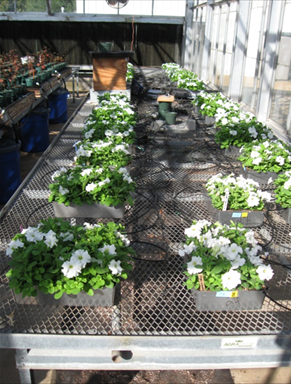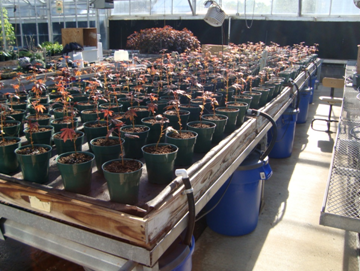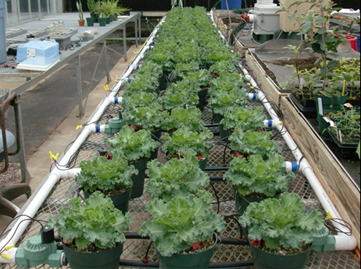You are here
Athens Campus
 Overview of the 32-plot sensor-controlled irrigation system at the UGA Riverbend research greenhouses.
Overview of the 32-plot sensor-controlled irrigation system at the UGA Riverbend research greenhouses.Greenhouse research for the SCRI-MINDS project is conducted at the Riverbend research greenhouses on the UGA campus in Athens, GA.
These are the main research greenhouses for the horticulture department. Facilities include glass-covered greenhouses with computerized environmental controls, growth chambers, and a headhouse with laboratory space.
Several systems have been set up for our research. The largest of our systems is a 32-plot irrigation system with two EC-5 soil moisture sensors in each plot. These sensors are connected to a Campbell Scientific data logger using multiplexers.
The datalogger measures those sensors, averages the readings of the two sensors in each plot, and then compares those averages to plot-specific set points. If the substrate water content drops below the set point, the datalogger uses a relay driver to open the irrigation valve for that plot, applying a small amount of water. This allows for precise control of substrate water content.
 Sensor controlled subirrigation system at the UGA research greenhouses in Athens.
Sensor controlled subirrigation system at the UGA research greenhouses in Athens.We recently used a similar approach to automate irrigation of 10 ebb-and-flow benches (3’ x 5’ each). We use three EC-5 sensors per bench, and irrigation is triggered based on the average reading of those three sensors. This system has been tested in a study looking at growth of Hibiscus acetosella and performed well.
Control of substrate water is not precise since the pots are subirrigated and we have no control over the amount of water that gets taken up by the substrate during an irrigation event. Thus, we can control precisely at which water content plants get irrigated, but not how much water is applied.
 Irrigation System controlled by Electrical conductivity (EC) and water content at the UGA research greenhouses in Athens.
Irrigation System controlled by Electrical conductivity (EC) and water content at the UGA research greenhouses in Athens. A third automated irrigation system is designed for control of both substrate water content and substrate EC (either bulk or pore water EC). Using sensors that can measure both substrate water content and EC, a datalogger can decide when a particular plot should be irrigated, and whether plants should be irrigated using plain water or fertilizer solution.
We have tested this system using Decagon 5-TE sensors and noticed that these sensors were not optimal for soilless substrates. We are currently testing Decagon’s new GS-3 soil moisture and EC sensor and hope that this new sensor will be a better solution for this system.
